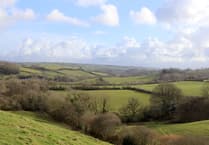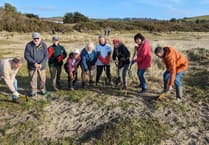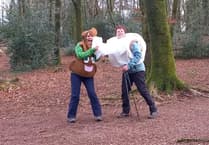WHEN I’m out walking the lanes around the village and spot a flat stone or even a lump of dead wood on the hedge, I always lift it up to see what might be living or hiding beneath it.
This is where you can see a small bug called a Woodlouse.
In fact, when the sun is shining warmly, the chance of spotting one is virtually nil as they suffer from not being able to stop themselves from drying out, so they hide away until the sun goes down when they can start to look for food in the shape of any scavenged material.
These woodlice were far from my mind when I was trimming back the evening primrose stalks and shaking the seed pods over a plastic bowl, as I always collect the seeds, and there, in the bowl was a Woodlouse trying to climb up the sides of the pan.
I quickly grabbed my camera and took a few close-up pictures as it walked around on its seven pairs of legs.
What’s so special about these little armoured bugs?
Well, according the Bill Bryson’s book A Short History of Nearly Everything, woodlice were probably the first mobile residents on dry land some 400 million years ago.
I will hazard a guess and say that they have not changed their shape from that time.
The following day was hot and sunny so I walked down towards Hepwell Mill and noticed quite a few Honeysuckle berries on the hedges and as I was photographing them, I heard the familiar honking sound of Canada geese.
Sure enough, when I looked into a nearby gateway, I spotted two of them walking around the field.
A large butterfly flew past me and then settled on the hedge. There is no problem identifying this one as the Comma butterfly with its ragged-edged orange wings and dark markings. This was the first one that I have seen this year, but according to British Wildlife magazine, their numbers are happily on the increase.
Walking uphill back to the village, I had my eyes glued to the vegetation on the hedge and saw four squash bugs.
These tiny brown bugs about 12mm long have particularly long antennae and always make me think of animals that existed back in the days of the dinosaurs.
Their body shape was used by Ferdinand Porsche when he was designing the Volkswagen car, which somehow acquired the name VW Beetle when I think it should have been ‘VW Bug’.
I spotted a couple more beetles on the hedge – why do hills make me walk even slower? – a Longhorn beetle about 20mm long with a yellow body with black marking, was feeding on pollen from some hogweed blooms.
Then, I came across a thin, metallic green beetle around 12mm long that was also feeding on a flower.
This one was a female Oedemera nobilis as she did not have the distinctive swollen hind legs of the male.




